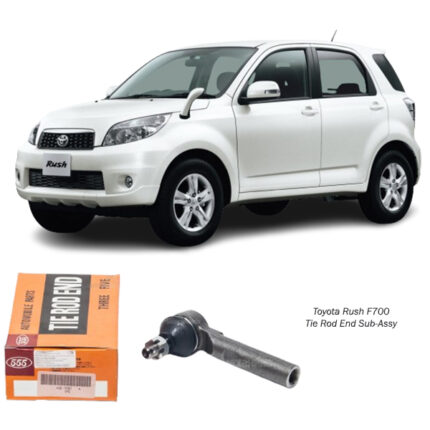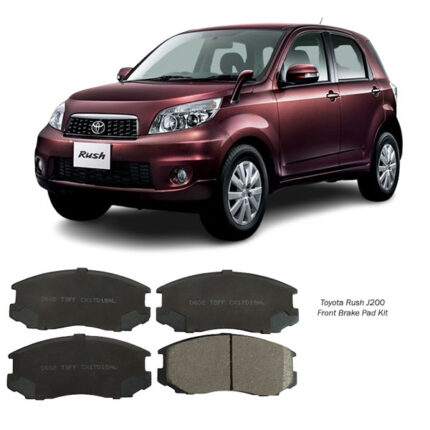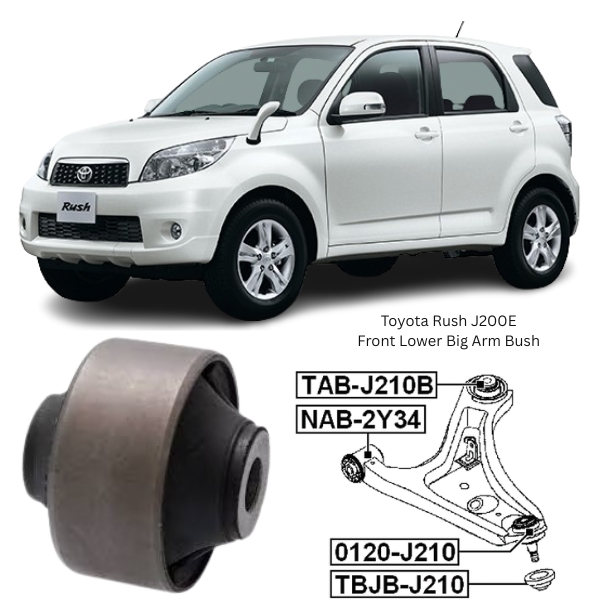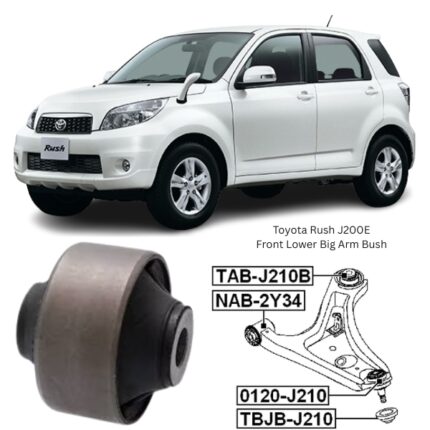Get Toyota Rush J200E Front Lower Big Arm Bush TAB-J210B in Kenya
The Front Lower Big Arm Bush is a key component within the front suspension system of a vehicle, responsible for providing a flexible and durable link between the chassis and the suspension arm. Often installed within the lower control arm—also referred to as the big arm—it plays a vital role in controlling the geometry, articulation, and overall stability of the vehicle’s front end.
This part functions as a pivot point, allowing the suspension to move up and down while isolating the cabin and chassis from harsh road vibrations and noise. Its importance in ensuring vehicle handling, alignment integrity, and ride comfort makes it one of the most critical bushings in the entire suspension architecture.
Primary Function
The Front Lower Big Arm Bush is designed to:
-
Absorb road shocks and vibrations transmitted through the wheel and suspension.
-
Maintain alignment geometry by holding the control arm in position during suspension travel.
-
Allow controlled arm movement for vertical wheel travel while minimizing lateral or rotational shift.
-
Reduce noise, harshness, and vibration (NVH), enhancing driver and passenger comfort.
-
Support load transfer during acceleration, braking, and cornering.
By effectively isolating metal-to-metal contact between the control arm and vehicle frame, the bush prevents premature wear of the suspension and steering components while contributing to precise vehicle handling.
Construction and Material Composition
The Front Lower Big Arm Bush is typically engineered from a combination of durable elastomeric materials and high-strength metal components, carefully bonded and molded to work under a range of operating conditions.
1. Outer Metal Sleeve
-
Usually made of corrosion-resistant steel or aluminum.
-
Provides structural rigidity and mounts securely into the control arm or subframe housing.
2. Inner Metal Sleeve
-
Fits around the suspension bolt or shaft, providing a pivot point.
-
Allows for secure attachment to the chassis and free movement of the control arm during suspension articulation.
3. Elastomer (Rubber or Polyurethane) Core
-
Acts as the damping medium between the inner and outer sleeves.
-
Rubber offers superior vibration absorption, while polyurethane provides added durability and resistance to wear and chemicals.
-
Some bushings may use advanced synthetic compounds for extended performance life.
4. Bonded or Floating Design
-
In bonded bushes, the elastomer is chemically or mechanically bonded to the metal sleeves for improved torsional resistance.
-
Floating bushes allow the inner sleeve to move within the elastomer, reducing stress and increasing longevity under specific conditions.
Location in the Suspension System
The Front Lower Big Arm Bush is press-fitted or bolted into the lower control arm—one of the main suspension arms connecting the wheel hub to the vehicle frame or subframe. Positioned at the pivot point of the arm, it absorbs and channels forces between the suspension and chassis, particularly during acceleration, braking, or turning.
Due to its location, the bush is subject to constant load, flexing, and environmental exposure, making durability and resilience essential.
Performance Benefits
A healthy and properly functioning Front Lower Big Arm Bush ensures:
-
Consistent Wheel Alignment: Maintains camber and caster angles within design specs, contributing to tire longevity.
-
Improved Handling and Steering Precision: Reduces front-end play or misalignment that may cause wandering or vague steering.
-
Better Ride Comfort: Absorbs small road imperfections that would otherwise transmit through to the cabin.
-
Reduced Braking Instability: Limits forward weight transfer-induced misalignment that can cause uneven braking or nose dive.
-
Enhanced Safety: Helps maintain proper suspension geometry, reducing the risk of component failure under load.
Signs of Wear or Failure
Over time, the bushing can deteriorate due to exposure to:
-
Heat and friction
-
Ozone and environmental contaminants
-
Constant compression, torsion, and rebound cycles
Common symptoms of worn or failed Front Lower Big Arm Bushes include:
-
Clunking or knocking sounds from the front suspension when driving over bumps or during turns.
-
Excessive wheel play or wandering, particularly while steering.
-
Unstable or loose handling, especially under braking or accelerating.
-
Visible cracking, splitting, or deformation in the rubber when inspected.
-
Uneven tire wear, suggesting alignment irregularities.
When these symptoms arise, timely inspection and replacement are critical to preserving vehicle performance and safety.
Installation and Replacement
Installing or replacing a Front Lower Big Arm Bush typically involves:
-
Lifting the Vehicle: Proper elevation to unload the suspension.
-
Removing the Control Arm: Unbolting it from the chassis and wheel hub.
-
Pressing Out the Old Bush: Often requires hydraulic or mechanical tools.
-
Cleaning and Preparing the Housing: Ensures a proper fit for the new bushing.
-
Pressing in the New Bush: Must be properly aligned and centered.
-
Reinstallation and Alignment: After replacing the bush, a full suspension alignment is often necessary.
While the job may seem straightforward, improper installation can lead to premature failure, suspension misalignment, or unsafe driving conditions. Therefore, the use of proper tools and techniques is essential.
Maintenance and Lifespan
While the Front Lower Big Arm Bush is considered a wear-and-tear item, its lifespan can vary greatly depending on:
-
Driving conditions (urban, off-road, highway)
-
Climate and exposure (extreme heat, moisture, road salts)
-
Driving style (aggressive cornering, hard braking)
-
Vehicle load and usage (frequent towing, payload weight)
On average, bushings may last between 50,000 to 100,000 kilometers, but should be visually inspected during routine suspension checks or when any handling issues arise.
No lubrication or servicing is typically required during its operational life unless part of a custom or aftermarket suspension system that includes greasable bushings.
Safety and Handling Considerations
Driving with a compromised or deteriorated lower big arm bush can lead to:
-
Compromised vehicle control, particularly during emergency maneuvers.
-
Suspension misalignment, affecting tire contact and increasing wear.
-
Vibration and noise, reducing comfort and driver confidence.
-
Increased stress on other components, such as ball joints, tie rods, and strut assemblies.
Timely replacement of this small but critical component ensures that the entire suspension system continues to function as engineered, maintaining proper wheel tracking and load balance.
Follow us on Facebook for more parts.





Reviews
Clear filtersThere are no reviews yet.